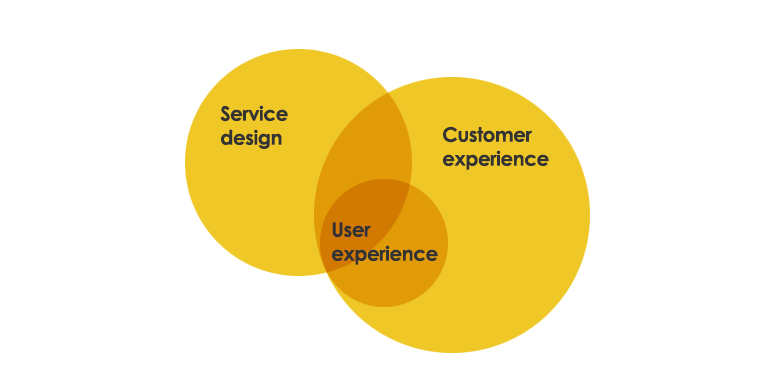
Differentiating Between User Experience, Customer Experience, and Service Design
The design world has evolved significantly over the years. Along the way, many new terminologies have popped up in the industry, resulting in professionals getting confused by some of them. For example, user experience, customer experience, and service design are three key terms that people often use interchangeably because of their similarities. However, in reality, they are not entirely the same.
When the Internet boomed in the 90s, the term “user experience” emerged due to the shift toward the digital landscape. However, as customers got engrossed in the online space, they started asking for more, which led to the birth of customer experience and service design. So to help you understand, here is some information about each concept and how they differ from each other.
User Experience (UX)
UX focuses on designing and developing all user interactions with a particular product or service. In most cases, these interactions occur digitally, such as through a website or mobile app, but the term may also apply to non-digital touchpoints like kiosks and mailers.
Overall, UX is concerned with usability. UX designers start by learning about what problems users face before conceptualizing possible solutions to address such pain points. Their main goal is to design products that are easy and intuitive to use.
Customer Experience (CX)
Over time, the scope of UX proved to be limited. As such, the term CX emerged to cover a broader range of interactions and emphasize the importance of customers. So, where UX focuses more on product or service interactions, CX encompasses all interactions across the customer journey, from awareness to consideration to conversion.
CX designers focus more on the brand level since their goal is to improve the overall customer experience and make it seamless. By this logic, CX includes UX but goes beyond this to understand how customers perceive interactions with your whole company—rather than a single product.
Service Design (SD)
SD involves planning and organizing resources to execute the processes needed to deliver a good user and customer experience. Unlike UX and CX, which are more front-facing, SD deals with the backend, focusing on the internal processes and parts of an organization and how they translate to user or customer interactions.
In other words, you can think of SD as the processes that happen behind the scenes to ensure that customers have a smooth experience at all times. While these processes are not visible to users, they impact their visible interactions. In that sense, SD considers the big picture—how different touchpoints connect to create the overall experience.
Key Differences Between UX, CX, and SD
Now that you know what UX, CX, and SD mean, you might have noticed some overlaps and distinctions. So to help you understand these concepts more check out their key differences below.
UX vs. CX
Among the three terms, UX and CX are perhaps the easiest to interchange due to the similarity in their names. However, as highlighted above, UX only focuses on one product or service, while CX considers all touchpoints in the customer journey. As a result, the latter also considers what users go through before, during, and after they interact with your product.
Another way to understand the difference is to consider their success metrics. For example, UX thinks about how a user feels about your product, while CX looks at the overall experience. Thus, UX measures success and abandonment rate, whereas CX measures customer satisfaction through positive reviews, word-of-mouth, the likelihood of recommending the company to others, and the like.
UX vs. SD
The main difference between UX and SD is that UX is the “what” and SD is the “how.” UX focuses on what product or service you are developing, since your goal is to design it as user-friendly as possible. Most of the time, UX design applies to digital products like websites and apps, so designers are in charge of developing wireframes and prototypes.
On the other hand, SD considers how you design your systems and allocate resources to enable end-to-end services for customers. With this process, you take a more holistic view by considering touchpoints in all aspects of the business—not just marketing and sales but also production, operations, customer support, and the like.
CX vs. SD
The distinction between CX and SD is essentially the same as in the discussion between UX and SD—CX is the “what,” and SD is the “how.” The only difference is that CX covers a more extensive scope. Essentially, CX focuses on what customers encounter when interacting with your brand, while SD talks about how you create and maintain such an experience.
This logic follows that good service design translates to a good customer experience. Therefore, if you separate one from another, you risk delivering an inconsistent experience, which may affect the overall customer perception of your brand.
Bottom Line
As you may notice, there are areas where these concepts may overlap. UXPA Boston offers one way to visualize them through three concentric circles. The innermost circle is UX, the middle circle is CX, and the largest circle is SD. With this perspective, you see how UX is a subset of CX and SD is the superset of all touchpoints, thus covering both UX and CX.
Given these overlaps, it is understandable why people may confuse user experience (UX), customer experience (CX), and service design (SD) for one another. However, they do not pertain to the same thing despite being related. UX focuses on product or service usability, CX looks at interactions across the entire customer journey, and SD involves designing the internal processes needed to provide a good experience on the front end.
Overall, the key to delivering a seamless and frictionless experience is coordinating efforts across all teams within the organization. It is not enough to focus on a single touchpoint as you need to engage with customers at every stage of the journey and provide a user-friendly product that addresses their pain points.



